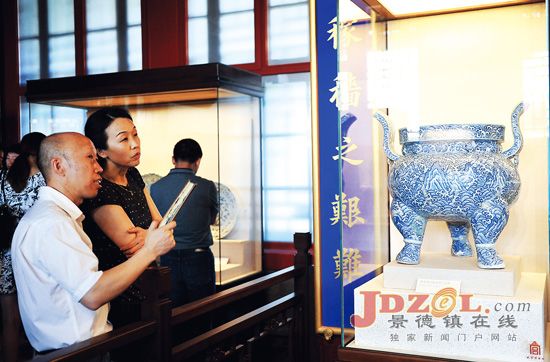
Visitors look at a piece of porcelain at the Palace Museum.
Some 160 pieces of porcelain deemed not good enough for China's royal court and shattered 580 years ago have finally made their way to the Forbidden City.
An exhibition at the Palace Museum about the Ming Dynasty imperial kilns in Jingdezhen, a porcelain town in Jiangxi Province, has brought pieces restored from unearthed ceramic chips together for the first time with the museum's well-preserved royal collections.
Lu Chenglong, deputy chief of the Utensil Department of the Museum, said the three-month-long exhibition, which closes on Sept. 3, was overdue.
"We have been planning this kind of exhibition since as early as the 1990s, but could not do it for various reasons," he said.
Through strengthened cooperation with local museums, especially the Institute of Archaeology of Porcelain of Jingdezhen City this year, the porcelain finally left Jingdezhen for Beijing to be displayed alongside 137 perfect vessels made from the same royal kilns.
"Although a great deal of royal porcelain has been passed down by the imperial families, there is so much we don't know about royal porcelain production at that time. Visitors can clearly observe the difference by comparing the substandard and perfect pieces," he said.
A man surnamed Wu who runs an antique store in Beijing has visited the exhibition twice in two months. "The comparison display is very valuable. It helps us improve our understanding of ancient porcelain," he said.
He noted that the defective pieces are either misshapen or have flawed colors or drawings.
Since the 1970s, Chinese archaeologists have unearthed dozens of tonnes of ceramic chips from the ruins of ancient royal kilns in Jingdezhen and restored 1,400 pieces so far.
"Restoring these chips is a huge and time-consuming project, but very valuable," said Lu Chenglong, who has been studying ancient porcelain for 31 years.
Due to fragility, wars, regime change, natural disaster and other factors, a large amount of porcelain that passed the quality inspection of kiln supervisors disappeared. Without archaeological excavation of the ancient royal kilns, knowledge of the royal kilns and the porcelain they produced would remain vague, said Lu.
One blessing to Chinese porcelain researchers, Lu said, is that ceramics, either chips or vessels, appear new after a wash, no matter how long they have been buried in the earth or a sunken ship.
History records show that during the reign of the Emperor Wanli from 1573 to 1620, the heyday of porcelain production in China, there were 100,000 people working with royal and private kilns in Jingdezhen alone. Some of their products were exported to Africa, Europe and the Americas.
At the exhibition, ten vessels, including an octagonal candle holder, stand out for their Islamic influence. Lu Chenglong said they were evidence of the impact of Islamic culture on ceramics of the era.
Visitor Yuan Xiaomei from Heilongjiang Province was surprised by the tough production standards of ancient royal kilns.
"The restored pieces are exquisite enough in my eyes, but still they were shattered and buried. Such high standards could be one of the reasons why our porcelain-firing techniques were best in the world at that time," she said.
Lu said that these defective pieces provide precious sources for the study of China's antique porcelain, and restoration work is moving forward.
The Palace Museum has a collection of 360,000 pieces of porcelain.
The exhibition has received more than 1,000 visitors per day.


















































